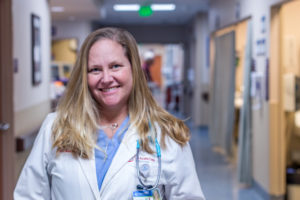Opioid Treatment in the ED: A Revolving Door, or an Open Door?

“When he came to me for treatment he was six years in,” Sampson said in a recent interview. “He had lost everything. He told me he wanted his life back. We were the ones who provided an open door for treatment.”
Overcoming Stigma
When Sampson started the opioid treatment program in Placerville – the program is part of a state-wide effort by the organization ED-BRIDGE to get treatment for opioid addiction started while patients are still in the ED – the main obstacles she encountered were cultural. There was a sense that it was opioid abusers’ own fault.
In 2017 alone, over 72,000 Americans died of drug overdoses, most as a result of opioids, according to numbers from the Centers for Disease Control and Prevention. That’s more Americans than died over the course of the entire Vietnam War. The opioid epidemic has been a growing crisis for years. Yet, until recently, most EDs focused little on getting patients enrolled in long-term treatment programs.
“Usually, they’re given medicines that help with vomiting and diarrhea and sent on their way, maybe with a few numbers to call about treatment,” wrote journalist Abby Goodnough in an extensive New York Times article last year that profiled new treatment programs (Sampson was quoted in the article).
Sampson, like many others on the front lines of the opioid epidemic, was convinced by a landmark study from Gail D’Onofrio, a researcher at Yale University, that he ED needed to change its approach. D’Onofrio found that addicted patients who received buprenorphine in the emergency room along with a referral to supportive treatment were twice as likely to still be in treatment a month later than those who were only given an informational packet.
Another statistic that stuck with Sampson: 10 percent of patients who present to the ED with some opioid-related issue are dead within a year. The more she learned about the science, the more she realized that giving patients buprenorphine would save lives, plain and simple.
“We all have standard pathways to do evidence-based treatment for sepsis, STEMI, and stroke. So, when I really sat down to think about it, I thought, why aren’t we doing evidence-based treatment in our ER for opioids,” Sampson said. “In my opinion, the only thing getting in the way was stigma.”
How did Sampson overcome that stigma? With stories like that of the star athlete whom she treated. Most healthcare providers only need to be asked, “What if it was your kid?” said Sampson. If it was your kid, which approach would you want the ED to take?
An Open Door
For the 16 years that Sampson had been working in the ED, they had done what is known as “supportive treatment.” In other words, give patients a list of treatment facilities and say good luck. But when Sampson learned about the alternative approach, she started leading a change.
“I think everyone thinks, ‘not my kid, not my family member.’ I can’t tell you how many wonderful people have approached me and thanked me in tears for the open door. They have great jobs, great careers, but there’s someone in their family with an issue,” Sampson said.
Since the program started in 2017, Sampson’s ED has treated roughly one person each week through the program. “The floodgates did not open,” she said. Patients are scored to determine whether they are in moderate to severe withdrawal. Those who are currently intoxicated or on other drugs are excluded and told to come back later. Those patients who qualify are given a dose of buprenorphine and are also set up with an appointment at a local clinic. The buprenorphine dose is enough to get them to the appointment. The drug works by activating the same receptors in the brain that other opioids do, but without the accompanying high. A majority of patients are treated through the department’s Fast Track.
At the clinic, patients are given counseling and group therapy twice a week in what is called Phase 1. Once they’ve had clean drug tests and regular attendance, they graduate to Phase 2, which reduces the counseling to every other week.
D’Onofrio’s study shows that programs like this indeed save lives – and Sampson says many patients have specifically thanked her and other providers she works with for precisely that: saving lives.
“They shout across the ED to tell us. They really see it as, we had the open door for them. We treated them and go them into a clinic the next day.”
Expanding the Program
Sampson was recently named co-director of a statewide program with the goal of putting Treatment Navigators in 30 EDs across the state. The aim is to meet patients where the are at an provide 24/7 access to treatment for any substance use disorder.

